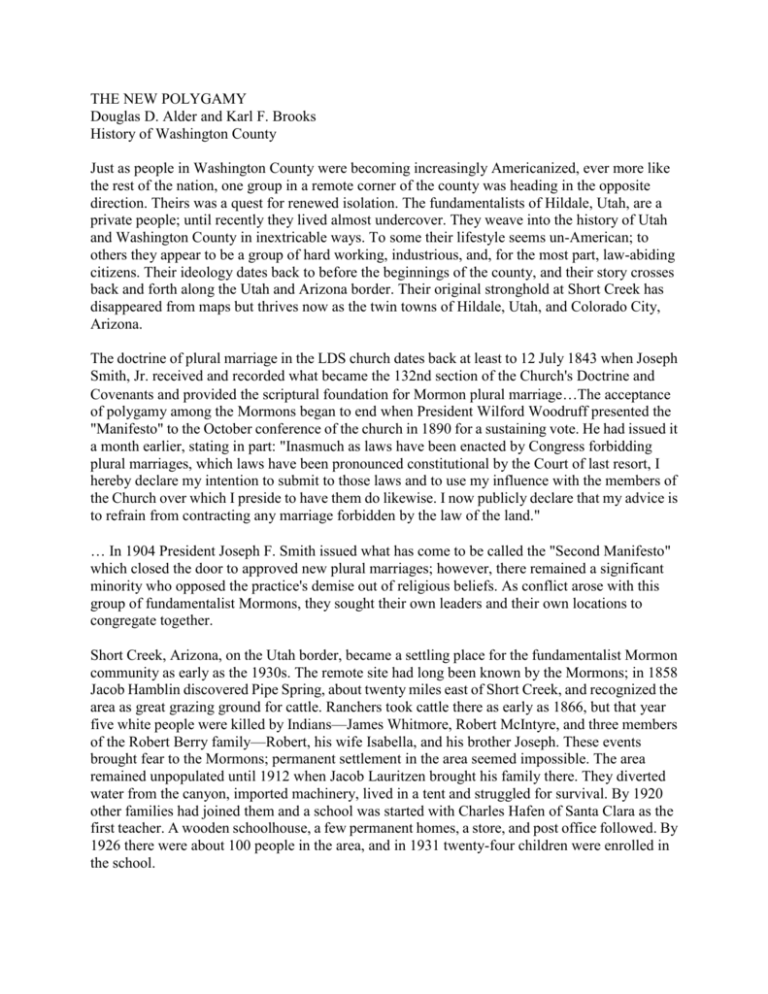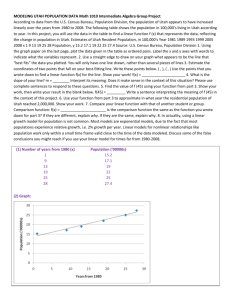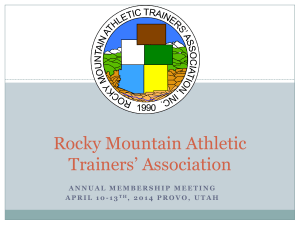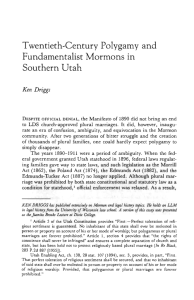MF0046 - Mormon Polygamy Documents
advertisement

THE NEW POLYGAMY Douglas D. Alder and Karl F. Brooks History of Washington County Just as people in Washington County were becoming increasingly Americanized, ever more like the rest of the nation, one group in a remote corner of the county was heading in the opposite direction. Theirs was a quest for renewed isolation. The fundamentalists of Hildale, Utah, are a private people; until recently they lived almost undercover. They weave into the history of Utah and Washington County in inextricable ways. To some their lifestyle seems un-American; to others they appear to be a group of hard working, industrious, and, for the most part, law-abiding citizens. Their ideology dates back to before the beginnings of the county, and their story crosses back and forth along the Utah and Arizona border. Their original stronghold at Short Creek has disappeared from maps but thrives now as the twin towns of Hildale, Utah, and Colorado City, Arizona. The doctrine of plural marriage in the LDS church dates back at least to 12 July 1843 when Joseph Smith, Jr. received and recorded what became the 132nd section of the Church's Doctrine and Covenants and provided the scriptural foundation for Mormon plural marriageThe acceptance of polygamy among the Mormons began to end when President Wilford Woodruff presented the "Manifesto" to the October conference of the church in 1890 for a sustaining vote. He had issued it a month earlier, stating in part: "Inasmuch as laws have been enacted by Congress forbidding plural marriages, which laws have been pronounced constitutional by the Court of last resort, I hereby declare my intention to submit to those laws and to use my influence with the members of the Church over which I preside to have them do likewise. I now publicly declare that my advice is to refrain from contracting any marriage forbidden by the law of the land." In 1904 President Joseph F. Smith issued what has come to be called the "Second Manifesto" which closed the door to approved new plural marriages; however, there remained a significant minority who opposed the practice's demise out of religious beliefs. As conflict arose with this group of fundamentalist Mormons, they sought their own leaders and their own locations to congregate together. Short Creek, Arizona, on the Utah border, became a settling place for the fundamentalist Mormon community as early as the 1930s. The remote site had long been known by the Mormons; in 1858 Jacob Hamblin discovered Pipe Spring, about twenty miles east of Short Creek, and recognized the area as great grazing ground for cattle. Ranchers took cattle there as early as 1866, but that year five white people were killed by Indians—James Whitmore, Robert McIntyre, and three members of the Robert Berry family—Robert, his wife Isabella, and his brother Joseph. These events brought fear to the Mormons; permanent settlement in the area seemed impossible. The area remained unpopulated until 1912 when Jacob Lauritzen brought his family there. They diverted water from the canyon, imported machinery, lived in a tent and struggled for survival. By 1920 other families had joined them and a school was started with Charles Hafen of Santa Clara as the first teacher. A wooden schoolhouse, a few permanent homes, a store, and post office followed. By 1926 there were about 100 people in the area, and in 1931 twenty-four children were enrolled in the school. The tie to Mormon fundamentalism for Short Creek came when Isaac Carling went to Salt Lake City to work in the Baldwin Radio plant. Nathaniel Baldwin was an important Utah inventor and industrialist who became the financial patron of the fundamentalist movement. Many of his corporate officers and other employees were active in the movement in Utah; among them were Lorin C. Woolley, John Y. Barlow, Israel Barlow, Leslie Broadbent, and Lyman Jessop. Increased pressure from the LDS church served to polarize fundamentalists, and many looked to Short Creek as the future home of the movement. The Utah Legislature elevated "unlawful cohabitation" from a misdemeanor to a felony in 1935, which made the border town look more attractive as a place where practitioners of plural marriage could step across the Utah line quickly to avoid arrest. With the conviction of Price Johnson and I. Carling Spencer in December 1935 in an Arizona court, the state line between Utah and Arizona became even more important, as polygamists could avoid law-enforcement officers from either direction. In October 1936, the Declaration of United Trust was filed and recorded in Kingman, Arizona, legally creating a trust and taking a giant step toward a united order lifestyle for area polygamists. In November 1942, a new United Effort Plan (UEP) trust was recorded in Kingman, Arizona, strengthening and making clearer the legality of the trust. The decades of the 1940s and 1950s saw considerable conflict between the fundamentalists and government officials, as well as some internal conflict. In 1953 a raid by the Arizona state government to break up the community by taking children away from parents was a dismal failure. Though 263 children were seized, within three years all had been returned to their families in what had become an expensive and unpopular public embarrassment. The raid was traumatic for all and today has gained legendary status. This would also represent the last legal prosecution of fundamentalists affiliated with the Short Creek community for practicing plural marriage. In 1961 an oiled road was finished from Hurricane, Utah, to Fredonia, Arizona. This opened access to Short Creek and in a symbolic way exposed the fundamentalists to the world. The name of the location was officially changed the following year to Colorado City for the Arizona side and Hildale for the Utah side. Hildale was incorporated as a Utah town in 1962. The area has grown, and the combined communities numbered more than 4,000 residents in 1995. Education is important to the fundamentalists with about 1,500 students enrolled in elementary and secondary schools in the two communities. College also is considered important and the United Effort Plan often financially assists students to attend college and apply their skills for the common good. Some students enroll at Dixie College or at Southern Utah University, but most attend the branch of Mojave Community College in Colorado City. Recently the fundamentalists of Colorado City opened the John Y. Barlow University. As yet unaccredited, it aspires to become a much larger center of learning for its members. Under the leadership of mayors Dan Barlow of Colorado City and David Zitting of Hildale, the area has enjoyed economic growth and positive interaction with the outside world. A new airport, a manufacturing plant, a convenience store, and a restaurant all suggest economic vitality. After the death of Leroy Johnson in 1986, an internal conflict among fundamentalists spilled over into a bitter federal-court battle. A minority group of plaintiffs has contended that the United Effort Plan trust was a business venture from which they could withdraw, taking their contributions as well as title to real property that they had occupied but which had been deeded to the trust. The much larger majority defendant group contends that the UEP was a voluntary charitable organization advancing the religious community, which means the past contributions were gifts and need not be refunded. This has divided the community and families and led to creation of a splinter group that calls itself the "Second Ward." The dispute has more to do with legitimate religious authority than it does with polygamy. A final decision was hailed by both sides as a victory; it allowed the trust to evict the splinter group but not without compensating those who were put out. Hildale-Colorado City has grown in numbers, prospered financially, and gained confidence as a religious community. Members of the two towns are usually easily identified by their modest dress, conservative hairstyles, and lack of makeup. Due to their common large family structure, many can get a real bargain when they purchase a family pass to some events being held in the area. The median family income is low, partly because family incomes have to be divided among so many. The Hildale–Colorado City area has opened up considerably, looking to improve its relationship with the outside world while retaining its unique religious culture. Economic expansion in Colorado City and in other group holdings has accelerated with the development of cabinet making, commercial landscaping, chicken and egg farming, candy making, and other businesses. Innovative public school financing and aggressive expansion of public services continues under both church and civic sponsorship. Internal conflict in the UEP remains, but the Short Creek community seems clearly here to stay.









